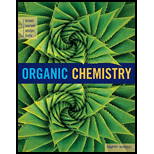
Concept explainers
(a)
Interpretation:
Mirror image of the given molecule has to be drawn and also whether the original molecule and its mirror image is the same or different has to be checked.
Concept Introduction:
Chiral center:
A tetrahedral atom that is bonded to four different groups is called as chiral center. The most commonly known tetrahedral atom is carbon.
(b)
Interpretation:
Mirror image of the given molecule has to be drawn and also whether the original molecule and its mirror image is the same or different has to be checked.
Concept Introduction:
Chiral center:
A tetrahedral atom that is bonded to four different groups is called as chiral center. The most commonly known tetrahedral atom is carbon.
(c)
Interpretation:
Mirror image of the given molecule has to be drawn and also whether the original molecule and its mirror image is the same or different has to be checked.
Concept Introduction:
Chiral center:
A tetrahedral atom that is bonded to four different groups is called as chiral center. The most commonly known tetrahedral atom is carbon.
(d)
Interpretation:
Mirror image of the given molecule has to be drawn and also whether the original molecule and its mirror image is the same or different has to be checked.
Concept Introduction:
Chiral center:
A tetrahedral atom that is bonded to four different groups is called as chiral center. The most commonly known tetrahedral atom is carbon.
(e)
Interpretation:
Mirror image of the given molecule has to be drawn and also whether the original molecule and its mirror image is the same or different has to be checked.
Concept Introduction:
Chiral center:
A tetrahedral atom that is bonded to four different groups is called as chiral center. The most commonly known tetrahedral atom is carbon.
(f)
Interpretation:
Mirror image of the given molecule has to be drawn and also whether the original molecule and its mirror image is the same or different has to be checked.
Concept Introduction:
Chiral center:
A tetrahedral atom that is bonded to four different groups is called as chiral center. The most commonly known tetrahedral atom is carbon.
(g)
Interpretation:
Mirror image of the given molecule has to be drawn and also whether the original molecule and its mirror image is the same or different has to be checked.
Concept Introduction:
Chiral center:
A tetrahedral atom that is bonded to four different groups is called as chiral center. The most commonly known tetrahedral atom is carbon.
(h)
Interpretation:
Mirror image of the given molecule has to be drawn and also whether the original molecule and its mirror image is the same or different has to be checked.
Concept Introduction:
Chiral center:
A tetrahedral atom that is bonded to four different groups is called as chiral center. The most commonly known tetrahedral atom is carbon.
Trending nowThis is a popular solution!

Chapter 3 Solutions
Organic Chemistry
- Propose a synthesis of 1-butanamine from the following: (a) a chloroalkane of three carbons (b) a chloroalkane of four carbonsarrow_forwardSelect the stronger base from each pair of compounds. (a) H₂CNH₂ or EtzN (b) CI or NH2 NH2 (c) .Q or EtzN (d) or (e) N or (f) H or Harrow_forward4. Provide a clear arrow-pushing mechanism for each of the following reactions. Do not skip proton transfers, do not combine steps, and make sure your arrows are clear enough to be interpreted without ambiguity. a. 2. 1. LDA 3. H3O+ HOarrow_forward
- b. H3C CH3 H3O+ ✓ H OHarrow_forward2. Provide reagents/conditions to accomplish the following syntheses. More than one step is required in some cases. a. CH3arrow_forwardIdentify and provide an explanation that distinguishes a qualitative and quantitative chemical analysis. Provide examples.arrow_forward
- Identify and provide an explanation of the operational principles behind a Atomic Absorption Spectrometer (AAS). List the steps involved.arrow_forwardInstructions: Complete the questions in the space provided. Show all your work 1. You are trying to determine the rate law expression for a reaction that you are completing at 25°C. You measure the initial reaction rate and the starting concentrations of the reactions for 4 trials. BrO³¯ (aq) + 5Br¯ (aq) + 6H* (aq) → 3Br₂ (l) + 3H2O (l) Initial rate Trial [BrO3] [H*] [Br] (mol/L) (mol/L) | (mol/L) (mol/L.s) 1 0.10 0.10 0.10 8.0 2 0.20 0.10 0.10 16 3 0.10 0.20 0.10 16 4 0.10 0.10 0.20 32 a. Based on the above data what is the rate law expression? b. Solve for the value of k (make sure to include proper units) 2. The proposed reaction mechanism is as follows: i. ii. BrО¸¯ (aq) + H+ (aq) → HBrO3 (aq) HBrO³ (aq) + H* (aq) → H₂BrO3* (aq) iii. H₂BrO³* (aq) + Br¯ (aq) → Br₂O₂ (aq) + H2O (l) [Fast] [Medium] [Slow] iv. Br₂O₂ (aq) + 4H*(aq) + 4Br(aq) → 3Br₂ (l) + H2O (l) [Fast] Evaluate the validity of this proposed reaction. Justify your answer.arrow_forwardе. Д CH3 D*, D20arrow_forward
 Chemistry: The Molecular ScienceChemistryISBN:9781285199047Author:John W. Moore, Conrad L. StanitskiPublisher:Cengage Learning
Chemistry: The Molecular ScienceChemistryISBN:9781285199047Author:John W. Moore, Conrad L. StanitskiPublisher:Cengage Learning
